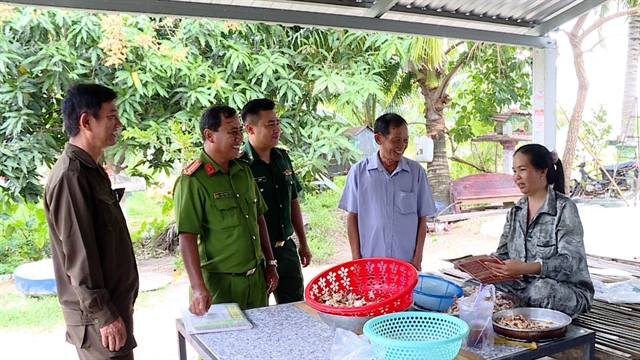 Society
Society

.jpg) |
| Hoà Bình hydropower reservoir in Hoà Bình Province. — VNA/VNS Photo |
HÀ NỘI — Experts say the lack of integration between industrial and urban growth and water source security has resulted in declining water quantity and quality, jeopardising water security.
Despite efforts, challenges persist in safeguarding water sources and reservoir safety.
Weak and ineffective water resource management heightens the challenge, compounded by insufficient awareness and responsibility among stakeholders. Water pollution also continues to worsen.
Associate Professor Nguyễn Đăng Tính, Deputy Director of the branch of the Water Resources University in HCM City, said that safety issues concerning water reservoirs built in the 1970s-1980s are a significant concern.
Urgent research is needed to enhance dam waterproofing and establish emergency protocols.
He also stressed the necessity of an integrated monitoring system for smart reservoir management and safety assessments, alongside digital transformation for infrastructure improvements.
Professor Tăng Đức Thắng, former Deputy Director of the Việt Nam Institute of Water Resources Science, underscored the Mekong Delta's vulnerability to climate change, sea-level rise and land subsidence, advocating adaptive strategies to ensure a rational water regime and mitigate risks, especially in agriculture.
Additionally, it is vital to integrate water security, flood prevention, and delta conservation into regional and national socio-economic planning.
This includes long-term strategies for water security, flood prevention across the Mekong Delta, coastal erosion protection and combatting saline intrusion.
Moreover, proactive measures are needed to address freshwater scarcity, including feasibility studies for new reservoirs within the Vàm Cỏ River system.
Lastly, research and forecasting of coastal water regimes are essential for aquaculture development in the Mekong Delta.
The Việt Nam Institute of Water Resources Science reported significant progress in water resource management from 2013 to 2023.
Various advanced technologies, including water extraction, treatment, and distribution systems for highlands and water-scarce regions, have been adopted nationwide.
Monitoring and flood control infrastructures are now operational in key river basins, such as the Hương and Vu Gia - Thu Bồn rivers, aiding the Central Steering Committee for Natural Disaster Prevention and Control in its decision-making.
Coastal protection efforts, such as planting wave-resistant trees, have been implemented in several provinces, including Thanh Hóa, Ninh Bình, Nam Định, Quảng Ninh, Hà Tĩnh, Quảng Trị, Trà Vinh, Sóc Trăng, Cà Mau, Bạc Liêu and Kiên Giang.
Innovative embankment technologies and sediment replenishment are being utilised in construction projects in Cà Mau Province.
Additionally, comprehensive flood risk maps and mitigation strategies have been developed for densely populated areas and urban, mountainous regions in the North, as well as downstream and storm surge-prone zones in coastal provinces like Thanh Hóa, Quảng Bình, Thừa Thiên - Huế and the Mekong Delta.
Advanced technologies like pile-supported dams, barrage dams and modular culverts have undergone extensive research and improvement, applied across various river control projects nationwide, including flood prevention in HCM City and freshwater-saltwater barriers in the Mekong Delta such as the Cái Lớn - Cái Bé project.
Integration of scientific and technological advancements has resulted in a 20 per cent reduction in irrigation water usage, yield increases of 5 to 11 per cent, and reduced greenhouse gas emissions in agriculture. Tailored flood prevention solutions, including devices and specialised pumping equipment, address specific regional challenges like flooding, drought and water scarcity.
Ongoing research focuses on adopting innovative technologies, particularly in digital water resource management, dam safety monitoring and improving irrigation infrastructure efficiency. Advancements in surveying, design, materials, and construction techniques aim to ensure the safety of reservoirs, dams, river dikes, coastal dikes and disaster mitigation infrastructure, promoting rural development.
Policies and strategies for water security and dam safety are continually refined.
According to Professor Nguyễn Văn Tỉnh, head of the National Science and Technology Programme until 2030, the programme focuses on providing scientific evidence and practical support to enhance state management effectiveness, ensure water security, and ensure dam safety. It prioritises developing, applying, and transferring advanced technologies for efficient water resource management, socio-economic development, and climate change adaptation.
The programme has specific targets: 60 per cent of tasks yielding results applied or tested successfully, 30 per cent having intellectual property protection applications accepted, with 10 per cent obtaining exclusive patents or recognised solutions, and 20 per cent involving business cooperation.
Implementation of the programme will comprehensively address scientific and technological challenges related to water security and dam safety. This includes advanced solutions for water resource augmentation, efficient management, circulation and waste reduction, alongside proposals for smart, modern and innovative technologies linked with digital transformation to enhance dam and reservoir safety and utilisation efficiency.
Việt Nam is assessed as a country with relatively abundant water resources, with an average annual surface water volume of approximately 840 billion cubic metres. The country's water infrastructure includes over 7,500 dams and reservoirs, capable of storing more than 70 billion cubic metres of water. — VNS